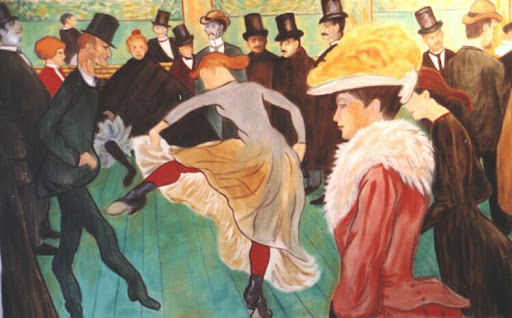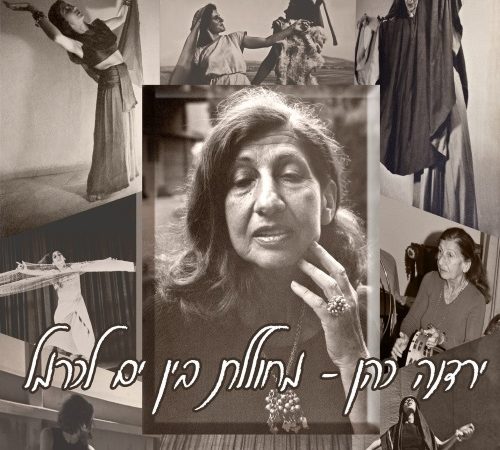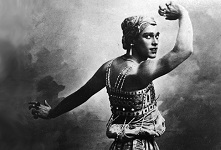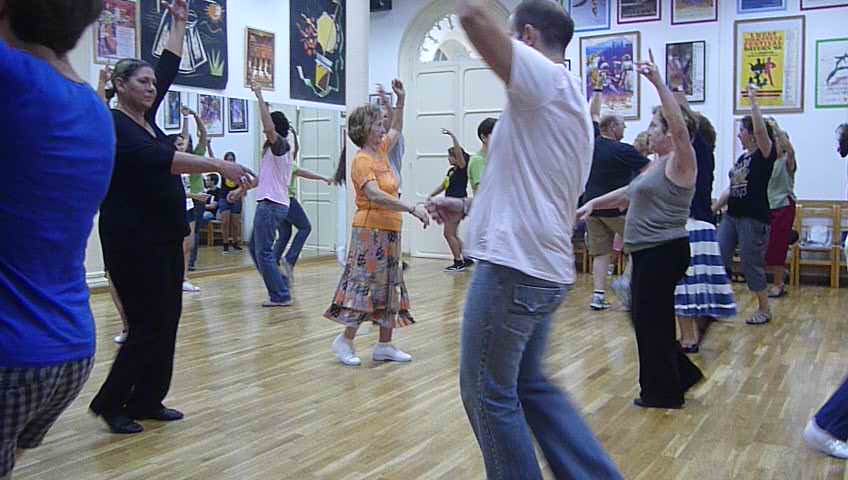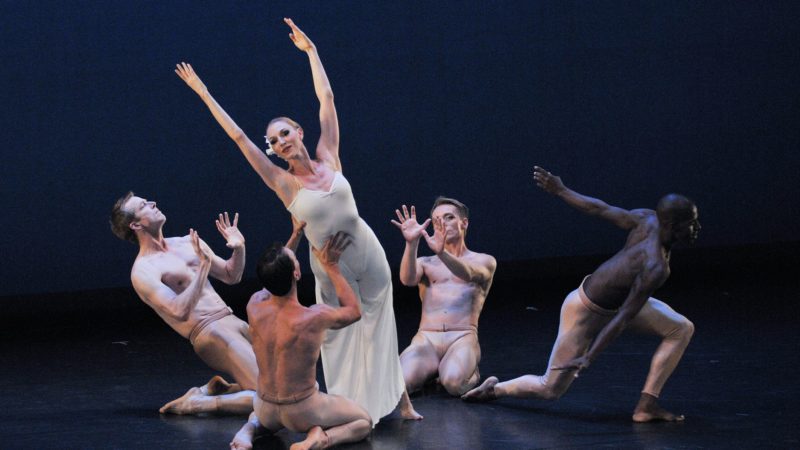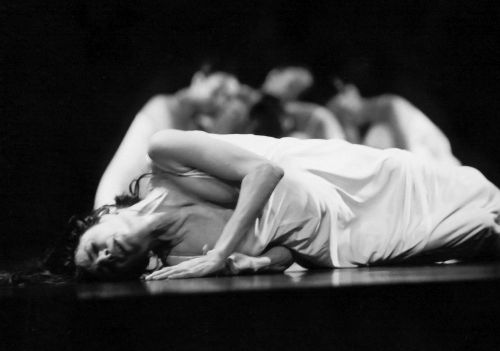Eroticism – Pornography for the Elite?
This paper, " Eroticism – Pornography for the Elite? A Close reading in Lea Anderson's The Featherstonehaughs Draw on the Sketch Books of Egon Schiele (1998) I submitted in the conference "Interdisciplinary Landscapes: Postfeminist Practices in the Arts" hels in University College Northampton, UK in 16th-18th September, 2004.
The distinct characteristics of Lea Anderson’s dance, The Featherstonehaughs Draw on the Sketch Books of Egon Schiele, is a hybrid relationship between dance and painting. Anderson, who created the dance in 1998 for her all-male company the Featherstonehaughs, started to choreograph in 1984 with the foundation of her all-female company, The Cholmondeleys. Since than she has established her reputation as a leading choreographer with her challenging works. Anderson, who systematically categorises her ideas and images in notebooks, is engaged in this dance with Schiele’s sketch books instead of her own. She combines conventions of pictorial art – movements and gestures, the flat surface, colour and the rhythm of the brush strokes – with her own discipline. Anderson’s images point to her need to represent not only the movements and gestures of Schiele’s models but to reconstruct an artistic structure within which they could be performed.
Schiele is regarded as one of the major exponents of Viennese Expressionism by art historians (Vergo, 1993; Kallir, 1981; Comini, 1978; Powell, 1974). In his short lifetime, between the years 1890 and 1918, Schiele produced an oeuvre of paintings and drawings ranging from landscapes to provocative nudes. Along with the appropriation of Schiele’s models of naked women, young girls, and self-portraits into the dance, another issue is raised – the artist’s reputation for pornographic drawings and paintings (Plates 1 & 2).
Eroticism or Pornography?
A black-framed picture of a figure pulling up its clothes to expose its bare torso is possibly the work Schiele mentioned in his prison diary as one that the police seized as ‘pornographic’. However, unlike other artists dealing with sexuality before him, Schiele, with his reputation for ‘pornographic’ drawings, was sent to prison for twenty four days, and one of his drawings was burned in front of him by the judge. The fact that within the history of erotic art there were many other painters who drew ‘blatant’ nudes, like Gustav Courbet or Édouard Manet, did not help Schiele in his situation. His art, according to Otto Benesch, “met with violent opposition on the part of the conservative majority of the Austrian public“ (1973, p. 199). Within the tendency of permissiveness at the turn of the twentieth century, the aspect of eroticism in Schiele’s art, with its deviation from the norm considered as ideal, became society’s Other, hence pornography.
Regarding Schiele’s work in relation to the history of erotic art raises the question of how it is determined which work is pornographic and which erotic. Or, as perceived in pictorial art in Western society, which is viewed as pbscenity and with as a traditional genre. When Anderson asks her all-male company to perform the movements and gestures of Schiele’s female nudes, she not only challenges tradition but also makes a strong feminist statement. Her feminist point of view exposes the position and bias of Schiele, a male artist representative of heteronormative culture of fin-de-siècle Vienna. At the same time, Anderson presents her ways of experiencing the world, declaring her own perspectives through her art, which is a recounting of how she, a member of a particular society, lives. The feminist movement and its critique are significant in the discourse of the boundaries separating eroticism from pornography, and it has become an important defining influence in Western society.
In one section of the dance, a dancer exits the stage, leaving his partner, who is dressed in a tight body leotard as if he were ‘naked’, to move and pose on a mattress. Two dressed dancers enter from upstage left, and one after another sit beyond the rectangular space on the folded mattress left behind from the previous section. The ‘naked’ dancer is posing for them, while also being aware of the audience in the theatre. The audience watch the drama in which the gazing spectators on stage and the dancer are participating. They watch the dancer move and pose before them with his legs wide apart, placing his hands over his genitals and raising his pelvis.
Michel Foucault (1990), who describes the various categories of sexuality as social and historical products, claims that not only have prohibitions on sexuality not decreased its manifestations, but in fact enabled the seeding and formation of a mosaic of sexualities. Distinctive pleasures thrived though channels of power; one of them is pornography, a medium that increases the power of marginal sexualities. Pornography, Foucault (1990) argues, combines power and pleasure within a mechanism of provocation and persuasion.
Thomas M. Messer (in Wilson, 1973) writes about Schiele’s erotic art that the artist felt compelled to visualise for himself and for others what had until then been relegated to the most private domain. Simon Wilson reasons that Schiele’s reputation as a pornographic draughtsman resulted from his frank depictions of the body, of “sexual anxieties of modern man” (1973, p. 29). The art historian Rosa Bush (1995) elaborates on this argument, claiming that Schiele’s art was denounced as pornography because he highly accentuated his nudes through action, colour, gaze and their participation in a sexual exchange. By doing so, she suggests, Schiele forced the viewer to “look into the hard stare of his subject, in order to look deep within him/herself [the viewer] to find the inner truth” (Bush, 1995, p. 10).
Pornography – an Artistic Genre
Gloria Steinem, who examines the definitions of ‘erotica’ and ‘pornography’ defines the erotic as “a mutually pleasurable, sexual expression between people who have enough power to be there by positive choice”, while she views pornography as characterized by violence and dominance (1980, p. 37). The rallying motto of the feminist anti-porn group, “porn is the theory, rape is the practice”, gives expression to a view of pornography as a social case of sexuality (in Kappeler, 1994, p. 35). Catherine MacKinnon (1989), a lawyer and anti-pornography activist, claims that pornography is the essence of a sexist social order, and that its explicit materials subordinate women through pictures or words. Furthermore, since pornography works within the traditional gender hierarchy, it institutionalises the supremacy of male sexuality. Pornography presents itself as fantasy or idea, she claims, while actually it distributes power in such a way that women’s rights are at stake.
Helen McDonald (2001), who outlines feminist contemporary debates concerning pornography within feminism, asserts that anti-pornography feminists tend to ignore pleasure alltogether. Deirdre English has recognised the dangers of feminism aligning itself with censorship and law, as the conservatives, she claims, usually “sponsor censorship crusades” against feminist books as well as pornography (in Kappeler, 1994, p. 36). This feminist approach denies that a link between pornography and criminal sexual practice in reality can be proven, and asserts a fundamental difference between fantasy and reality. Kappeler, who objects to the liberal approach, argues that what would significantly advance the discourse of pornography is the recognition that it is a form of representation, since these forms and their conventions have become ‘transparent’, as if they were reflections of reality, while they actually have “a genesis in material production” (1994, p. 3). She claims that the transparency of pornography takes us out of the comfortable seclusion of the Arts and leads us to examine the functions of its representations in society.
Angela Carter (2000) also takes an iconoclastic stand on this issue by not distinguishing between the two concepts, stating that eroticism is “pornography for the elite” (the title of this paper). Since sexuality is never expressed in a vacuum, she concludes, pornography “can never be art for art’s sake” (2000, p. 534). Of the several functions of pornographic literature, she asserts, the arousing of sexual excitement becomes the most significant function, and the narrative of pornographic literature turns flesh into words. Thus, although art may deal with verbal simulacrum, the reader, usually a man, applies the false universals of sexual archetypes to “purchase the flesh of other people as if it were meat” (Carter, 2000, p. 535). Pornography in art, according to Carter, always remains within the conventions of a system of values and ideas in a given society.
Already in 1969, Susan Sontag had referred in her article “The Pornographic Imagination” to three domains of pornography: in social history, as a psychological phenomenon, and within the arts. She claims that from the social and psychological standpoint all pornographic texts have the same status – they are documents. As a psychological phenomenon, for example, pornography is the representation of the fantasies of infantile sexual life for purchase by so-called adults, and social pornography becomes “the disease of a whole culture” (1969, p. 37). From art’s point of view, some of these texts may become ‘something else’. When she argues for the recognition of artistic values in certain contemporary pornographic literature, she refrains from the feminist movement’s negative attitude towards all kinds of pornography since, in her view, while pornography is commonly treated as only a social or psychological phenomenon and a locus for moral concern, there can be no argument that some books that she terms as pornographic are interesting and important as works of art. Georges Bataille takes a similar approach in his book The Accursed Share (1993), arguing that humanity forms various ‘worlds’ that exclude and ignore one another; two of these are eroticism and thought. It isn’t that man’s sexual activity is forbidden in principle, says Bataille; only eroticism that is “marked off by the violation of rules” is forbidden (1993, p. 124). Sontag suggests that “’the obscene’ is a primal notion of human consciousness, something much more profound than the backwash of a sick society’s aversion to the body” (1969, p. 57).
Sontag (1969) challenges the two definitions of pornography that Western society provides: the explicit representation of sexual acts, and the notion that it has no value but sexual stimulation. She does so in relation to The Story of O published under the pseudonym Pauline Réage and Bataille’s The Story of the Eye, both of which she claims are literature. Most of the arguments claiming that pornography is not literature are based on the view that the standards of literature are irrelevant to it, or that pornography is a lower class of literature. Sontag (1969), however, suggests that artistic standards of literature, such as narrative form, elegance of writing, and psychological credibility, are inherent in The Story of O. These elements are expressed in the same manner as in many non-pornographic works of contemporary fiction. The stronger accusation against pornographic works, Sontag writes, is that the sexual arousal of the reader is opposed to a genuine aesthetic experience. She opposes this argument by suggesting that other genres in popular literature resemble pornography in several ways. Detective stories, for example, stimulate physical reactions that are also an essential characteristic of pornography, and the use of a literary theme such as religious obsession is similar to themes in pornographic literature. Thus, Sontag asserts, “some of these [pornographic] texts cannot be refused accreditation as serious literature” (1969, p. 36).
In support of this argument, the art critic Arthur Roessler addresses the ‘offensive’ aspect of Schiele’s art, and writes: “anyone who sees in Schiele’s works of art only the nakedness, only the obscene nakedness and nothing else, is past helping” (in Schröder, 1995, p. 47). The feminist Pat Califia, in confessing that she is a sadist, claims that pornographic fantasies are not exclusively for men, but, represent the “human need for adventure, risk, competition, self-display, pleasurable stimulation and novelty” (in McDonald, 2001, p. 34). Thus she weakens the argument of the anti-pornography feminists who claim to speak on behalf of all women. Sontag elaborates on that point and says that pornography is an expression of the human imagination, and “he who transgresses not only breaks a rule. He goes somewhere that the others are not; and he knows something the others don’t know” (1969, p. 71). Any widening experience might be destructive for most people, and pornography is such an experience. Sontag’s position is that the issue should not be whether pornography acquires artistic values, but rather, what is the quality of the knowledge within pornography that enables it to be considered an artistic genre. In this light, Schiele’s pornographic art should be considered as art since it has doubtless artistic qualities.
In movement terms Anderson reconstructs Schiele’s poses, in this case from his ‘pornographic’ drawings of adolescent female models, using transitional movement. Although the male dancers do not perform these poses and gestures naked, their performance is saturated with desire. They accentuate the movements and poses of their loins performed knowingly to the gaze of the spectators (on stage) and audience (in the theatre). They touch their partners and caress them intimately and passionately, and use facial expression to express their desire. Anderson knowingly draws the spectator’s attention to a sense of continuity with the past, linking the dance to characteristic past representations of these poses as resonating with desire, as well as with aesthetic values. She makes it clear that she is well aware of the criticisms of Western ways of viewing and representing the female body (for instance, in John Berger’s Ways of Seeing, 1972) and of feminist theories of spectatorship. In her dance, she creates a unique field of power in which the various techniques of power – desire, sexuality, seduction, intensity – are distinguished. Through the changes she introduces into Schiele’s ‘pornographic’ representations, such as her choice that male dancers represent movement and gestures of Schiele’s female models, she reveals the power relationships that construct them and opens them to different ways of reading.
Conclusions
Anderson, aware of the changes that cultural practices have undergone since, copies the poses and gestures portrayed by Schiele, which were interpreted as pornography by some critics and scholars, while subjecting them to her own aesthetics. She addresses these issues not confrontationally, but rather interweaves her stance into her presentation of Schiele’s work within the dance. Aware of contemporary criticism of Western modes of representation of the female body and influenced by contemporary feminist criticism, she proposes a different reading of Schiele’s work. Her references to Schiele’s art stress the artistic quality within pornography, enabling it to be considered as an artistic genre. She challenges heteronormative culture without eliminating the female body from the dance. Thus, Anderson proposes a new cultural meaning of both the male and the female body, which is based on her view of the painter’s sexuality as depicted in his works.
References
Adshead, Janet (ed.) Dance Analysis: Theory and Practice. London: Dance Books, 1988.
Adshead-Lansdale, Janet. “Creative Ambiguity: Dancing Intertexts” in Adshead-Lansdale, Janet (ed.) Dancing Texts: Intertextuality in Interpretation. London: Dance Books, 1999, pp. 1-25.
Anderson, Lea. A resource pack of the production of Flesh and Blood. NRCD, 1994.
Barthes, Roland. “Diderot, Brecht, Eisenstein” in Revue d’Esthétique, Vol. 26, 1973, pp. 185-191.
__________. “The Death of the Author” in Image, Music, Text. Essays Selected & Translated by Heath, Stephen. New York: Hill & Wang, 1977, pp. 142-148.
__________. “That Old Thing, Art”, in Post-Pop. Ed. Paul, Taylor, Paul. Cambridge: MIT Press, 1989.
Benesch, Otto. “Egon Schiele as a Draughtsman” in Benesch, Eva (ed.) Collected Writings, Vol. IV. New York: Phaidon, (1950) 1973.
Briginshaw, Valerie. Lea Anderson Talks to Valerie Briginshaw about Flesh and Blood. Dance Matters 13, Summer 1995, pp. 4-8.
. “Getting the Glamour on Our Own Terms”. Dance Theatre Journal 12:3, Winter 1995-96, pp. 36-39.
Burt, Ramsay. Re-Presentations of Re-Presentations. Dance Theatre Journal 14:2, 1998, pp. 30-33.
Comini, Alessandra. Schiele in Prison. London: Thames and Hudson, 1974.
. The Fantastic Art of Vienna. New York: Alfred A. Knopf, 1978.
. Egon Schiele’s Portraits. Berkeley, Los Angeles, London: University of California Press, 1990.
Connor, Steven. Postmodernist Culture: An Introduction to Theories of the Contemporary. Oxford: Blackwell, 1997.
Chrisafis, Angelique. “The Old man and the urinal – Paris ponders a surreal question of the value of art”. The Guardian, 23 December 2006.
Crow, Thomas. “The Return of Hank Herron: Simulated Abstraction and the Service Economy of Art”. Modern Art in the Common Culture. New Haven, London: Yale University Press, 1996, pp. 69-84.
Doane, Mary Ann. “Film and the Masquerade: Theorising the Female Spectator”. Screen 23:3-4, Sept-Oct 1982, pp. 74-88.
Dodds, Sherril. “‘Perfect Moments, Immaculately Framed’: Lea Anderson and the Television Text”. Border Tension: Dance & Discourse. Proceedings of the Fifth Study of Dance Conference, Guildford, University of Surrey, April 20-23, 1995.
Dougill, David. “Moving Pictures”. The Times, 15 February 1998, p. 8
Eco, Umberto. “The Poetics of the Open Work”. The Role of the Reader: Explorations in the Semiotics of Texts. Bloomington and Indianapolis: Indiana University Press, 1979.
Foster, Hal. “Death in America”. October 75, Winter 1996, pp. 37-59.
Foucault, Michel. “What Is an Author?” in Rabinow, Paul (ed.) The Foucault Reader. London & New York: Penguin Books, 1984, pp. 101-120.
Goldberg, RoseLee. Performance Art: From Futurism to the Present. London: World of Art, 1996.
Graham, Martha. The Notebooks of Martha Graham. New York: Harcourt Brace Jovanovich, 1973.
Greenberg, Clement. “Modernist Painting” in Franscina, Francis & Harrison, Charles (eds.) Modern Art and Modernism: A Critical Anthology. London: Paul Chapman Publishing Ltd, (1965) 1982, pp. 5-10.
Hargreaves, Martin. “Profile Lea Anderson”. Dance Theatre Journal, 18:3, 2002, pp. 16-19.
Hutcheon, Linda. Modelling the Postmodern: Parody and Politics. A Poetics of Postmodernism: History, Theory, Fiction. London: Routledge, 1989, pp. 22-36.
__________. The Politics of Postmodernism. London & New York: Routledge, 1995.
Hutera, Donald. “The Boys get into a Viennese Whirl”. The Times, 10 February 1998, p. 34.
Jordan, Stephanie. The Cholmondeleys, Spring '88. Dance Theatre Journal 6:2, Fall 1988, p. 27.
__________. “Musical/Choreographic Discourse: Method, Music Theory, and Meaning” in Morris, Gay (ed.) Moving Words: Re-writing Dance. London & New York: Routledge, 1996, pp. 15-28.
Kallir, Jane. Austria’s Expressionism. New York: Rizzoli, Galerie St. Etienne, 1981.
. Egon Schiele. New York: Harry N. Abrams, 1994.
Krauss, E. Rosalind. “The Originality of the Avant-Garde”. The Originality of the Avant-Garde and Other Modernist Myths. Cambridge, Massachusetts, London: The MIT Press, 1985, pp. 151-170.
Levinson, Jerrold. “Hybrid Art Forms”. Journal of Aesthetic Education 18:4, Winter 1984, pp. 5-13.
Lynton, Norbert. The Story of Modern Art. London: Phaidon, 1995.
Marzorati, Gerald. “Art in the (Re)Making”. Artnews 85:5, May 1986, pp. 90-99.
Nebehay, M. Christian. Egon Schiele: Sketch Books. London: Thames and Hudson, 1989.
Parry, Jann. “Sketch a Lech”. The Observer Review, 15 February 1998, p. 7.
Powell, Nicolas. The Sacred Spring: The Arts in Vienna 1898-1918. New York: Graphic Society, 1974.
Prendergast, Christopher. The Triangle of Representation. New York: Columbia University Press, 2000.
Robertson, Allen. “G’day Schiele!” Time Out, 31 December – 7 January 1998, p. 19.
Sacks, Anne. “Learning to Live with Loss”. Dance Theatre Journal 15:4, April 2000, pp. 16-19.
Schorske, Carl, E. Fin-de-Siècle Vienna: Politics and Culture. New York: Alfred A Knopf, 1980.
Vergo, Peter. Art in Vienna, 1898 – 1918. London: Phaidon, 1993.
Watson, Keith. “Men Behaving Sadly”. Dance Theatre Journal 14:2, 1998, pp. 4-6.Wittgenstein, Ludwig. Notebooks 1914-1916. Wright, G.H. & Anscombe, G. E. M. (eds.) Oxford: Basil Blackwell, 1969.
Videography
Anderson, Lea and McKeirnan, Kevin. The Lost Dances of Egon Schiele, BBC and the Arts Council of England, 2002.
